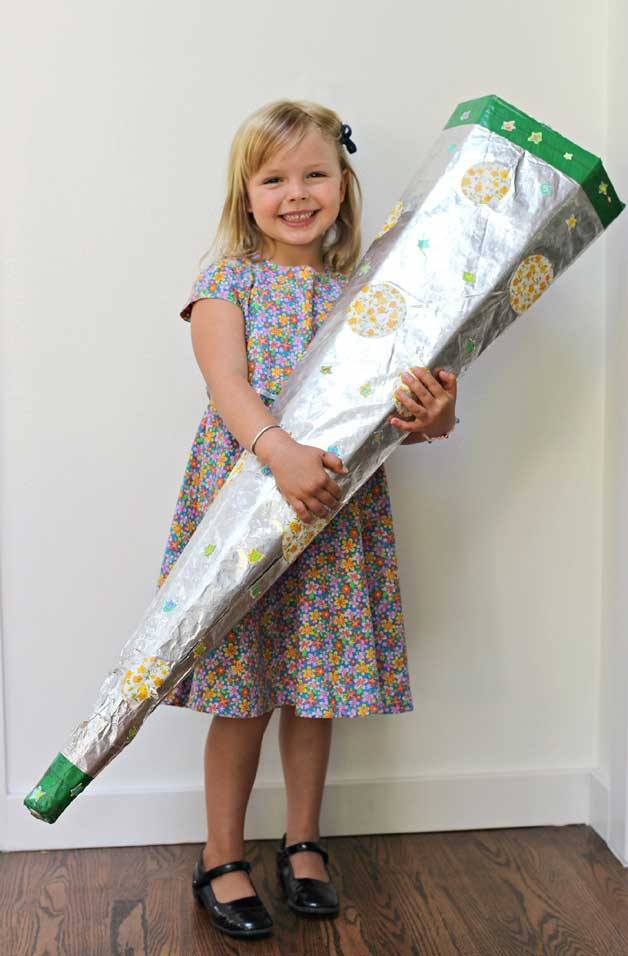Life is full of firsts. Your first word, your first steps, your first Christmas and, of course, your first day of school.
Entering kindergarten is a right of passage; you officially enter the world of academia.
Your first day of school is a day filled with apprehension and anticipation. Family traditions, like shopping for school supplies, can ease anxiety and get kids excited about their first day of kindergarten.
Islander Christa Hinchcliffe marks the occasion by carrying on a unique family tradition that connects to her German heritage: the Schultuete.
Essentially, a Schultuete is a cone-shaped bag that is filled with school supplies, treats, and/or toys, and is presented to children on their first day of kindergarten. The German word Schultüte [schul-too-ta] roughly translates to “school cone.”
The tradition of the Schultuete dates back to about 1810, where the first recorded Schultuete was created in Saxony and Thuringia in Germany.
The practice spread to the city of Jena in 1817, where the first cone-shaped Schultuete was created. Other larger cities, like Dresden and Leipzig, adopted the back to school ritual, and soon it became a common practice throughout Germany.
Family tradition
Hinchcliffe moved to Bainbridge Island about three years ago. She previously lived in Seattle and grew up in Snohomish.
In 1979, an article was published in the Everett Herald regarding Hinchcliffe’s family tradition, and featured a picture of her on her first day of kindergarten receiving her Schultuete from her grandmother.
Hinchcliffe’s grandmother, Gila, grew up in Berlin. Gila met Hinchcliffe’s grandfather during World War II, and became a war bride shortly after.
The Hinchcliffe family Schultuete was created by Gila in the late ’70s for Hinchcliffe’s first day of kindergarten.
Hinchcliffe’s sister, three cousins, nephew, and son have all celebrated their first day of school with the same Schultuete that Gila made. This fall, it will be time for Hinchcliffe’s daughter, Eliza, to receive the Schultuete.
Gila herself participated in this German tradition as a young girl in Berlin.
“She said because at that time they didn’t have a lot of money — it’s not like the Schultuete we see people on the Internet receiving today, which are filled with lots of toys — for her it was more things that she could actually utilize in school, like maybe some pencils or paper, and maybe even fruits and vegetables.” Hinchcliffe said.
“There might have been some wooden toy in there, but it was more utilitarian than it was actually fun, but it was still a really neat experience for her. I think she was really excited receiving it.”
A way to remember
Leaving one’s homeland can be traumatic and painful. Sharing home country traditions with one’s new family can help a person remember their heritage and adapt to their new environment.
“There’s other traditions, too, from Berlin that she shared with us,” Hinchcliffe said. “She’s very family oriented, and we have a very close family. So this tradition being important to her made it really important to me as well. It is very very close to her heart, so I wanted to share that with my kids, so hopefully we’ll be able to have them do that with their kids too.”
Five-year-old Eliza cannot wait for her first day of school at Wilkes Elementary School, and ecstatically awaits the big reveal of her goodie-filled Schultuete.
The Schultuete itself is 45 inches tall — slightly taller than Eliza herself.
When asked what she is most excited about come the first day of school, Eliza said, “seeing my new friend.”
Gila resides in Lake Stevens, and is not able to be present for Eliza’s first day of kindergarten. However, she is able to share in the experience through photographs and phone calls.
“She loves to see the pictures with the kids being ready for the first day of school holding the Schultuete, and she loves talking to them afterward to hear about their experience,” Hinchcliffe said. “It’s just really special to her.”
Since Hinchcliffe’s first Schultuete experience, she has altered the tradition so that the items in each child’s Schultuete echo the child’s interests and comply with school supply requirements.
“We have probably evolved [the tradition] a little bit since I first received the Schultuete,” Hinchcliffe said. “When we did it for my son, we did put school supplies in there, and then we also put a couple pieces of candy and a couple little toys in there, so a mixture of things.”
“I would definitely say we personalize it more,” Hinchcliffe added. “Like, for example, with Eliza, she really loves art. So what we would probably do is personalize her Schultuete more towards that, so getting her more art supplies. She wouldn’t necessarily need them for the first day of school, but that would be still nice for her to have to augment her areas of interest. We’re not doing just generic stuff in there, we’re trying to finds things that would match their personalities.”
Though the practice of the Schultuete is rare in the United States, Hinchcliffe said that any family can adopt the ritual and create their very own Schultuete.
“The one that we have is homemade,” Hinchcliffe said. “It’s just made from cardboard, and then it has wrapping paper around the outside with pieces that are cut out from foil to make it kind of shiny and just give it a little design, so definitely people can personalize it.”
Gila’s great-grandchildren proudly carry on a beloved tradition from her homeland, and hopefully, one day, her great-great-grandchildren will as well.
“I just think it’s so neat that my grandma brought this tradition from Berlin, and that she’s made it so important for us as individual kids to pass on that tradition.” Hinchcliffe said. “I’m just honored to be able to have that tradition in our family, and be able to share that with her.”


